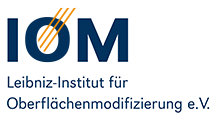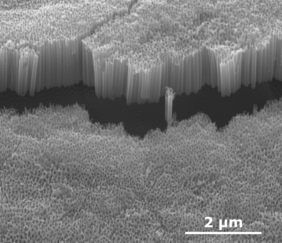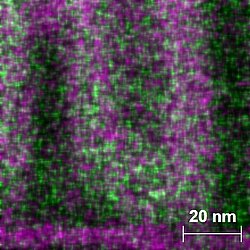Titania nanotube arrays are a versatile material for many applications ranging from devices for water cleaning to efficient solar cells and scaffolds for tissue culture. Scientists from the Leibniz Institute of Surface Engineering e.V. (IOM) have succeeded in drastically enhancing these nanotube arrays. Upon ion irradiation, carbide and oxide domains separate on the atomic scale. This leads to an increased conductivity and enables the development of smart biosensors.
Nanotube arrays consist of millions of single tubes having a diameter a thousandth smaller than a human hair. They are hexagonally arranged and offer an enormous surface area (Figure 1). Thus, nanotube arrays are often applied to clean water (in the function of a filter membrane) and to improve chemical reactions (in the function of a photocatalyst). Characteristics of nanotube arrays can be easily modified, and, in this way, can be tailored for various applications.
The working group „Biocompatible surfaces and nanoobjects“ led by Prof. Mayr established a new way to change the atomic composition of titania nanotube arrays upon ion implantation. Carbon ion implantation with energies of 60 keV to 150 keV results in decomposition of the material. Hence, separated, but partly connected carbon and oxygen domains form. These domains have characteristic average sizes of about 10 nm and uniformly appear in all implanted regions of the nanotubes (Figure 2). In fact, this phenomenon can only emerge in nanostructures, specifically in nanotubes, as the team confirmed with computer simulations. “Such a compositional patterning cannot be observed in thin films, nor in bulk samples. Our calculations show that the enthalpy within films is a critical parameter and normally impedes the decomposition” explains Prof. Mayr. The separation of carbon-rich and oxygen-rich domains implies a change of the atomic structure and results in extraordinary, yet undiscovered physical properties. „Even low ion fluences drastically enhance the conductivity of the nanotube arrays. Additionally, the amorphous structure and the nanotube morphology stay intact“ says the scientist Astrid Kupferer, a scholar of the Heinrich Böll foundation working on this topic at IOM. Local ion implantation paves the way for a manifold of developments. For instance, biosensors can be realized that specifically recognize the binding of single molecules.
The results of this study have now been published in the renowned journal Advanced Functional Materials:
Compositional Patterning in Carbon Implanted Titania Nanotubes
Astrid Kupferer, Alexander Holm, Andriy Lotnyk, Stephan Mändl, Stefan G. Mayr
Adv. Funct. Mater. 2021, 2104250
https://doi.org/10.1002/adfm.202104250


